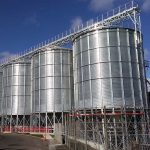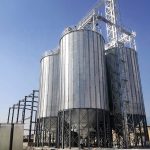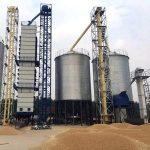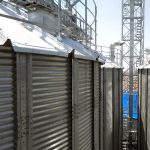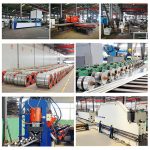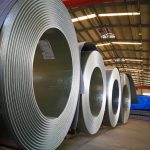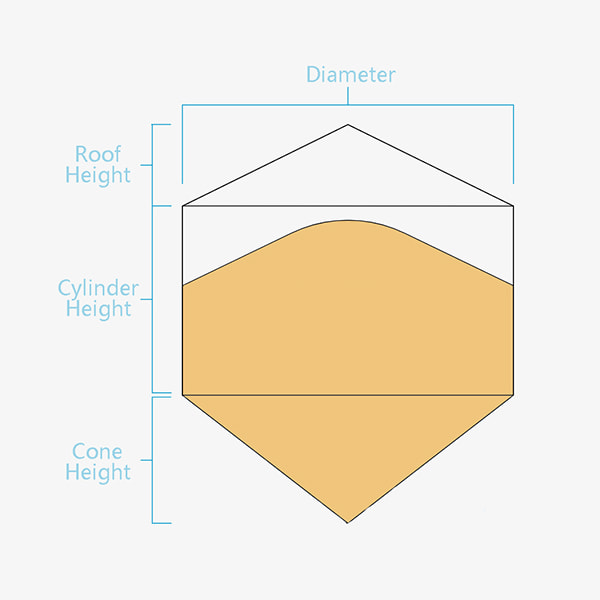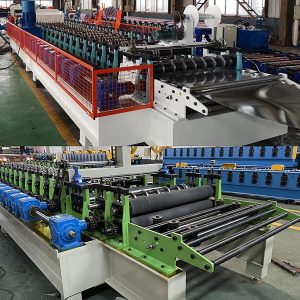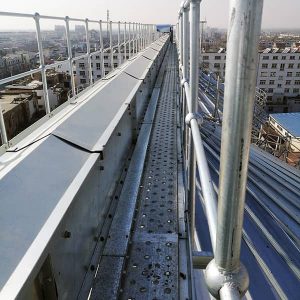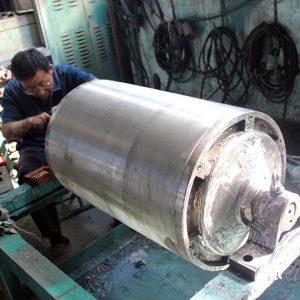Hopper Bottom Silo
A corrugated steel hopper bottom silo is an advanced grain storage equipment, it is useful for storing various grains, and seeds, including:
- Barley
- Beans
- Cereal
- Corn
- Granules
- Maize
- Paddy Rice
- Sorghum
- Sunflower seeds
- Soy
- Wheat
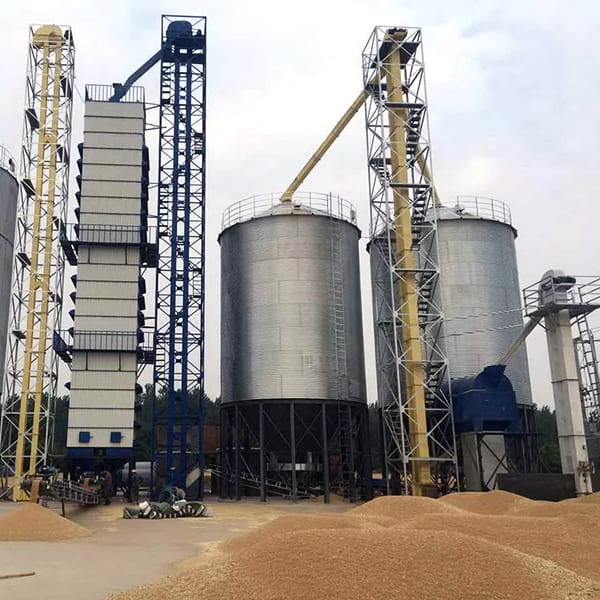
Its cone degree is between 35 to 60, and the grain can flow out of the conical silo on its own under gravity, without residue.
The 60-degree cone bottom silos are suitable for storing larger viscosity particles & powdery materials.
Features
As the hopper tanks don’t need a sweep auger for material unloading, which not only simplifies the assembly work but also reduces the total cost.
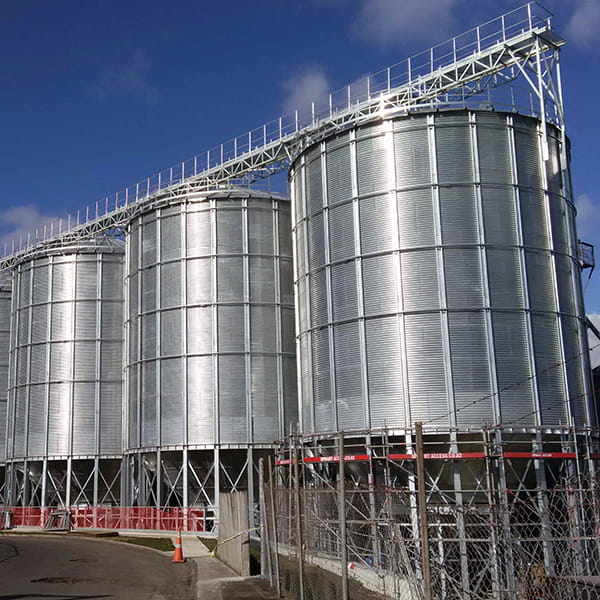
In addition, the following features of the hopper silo are also attractive:
- Short construction period;
- Optional temperature measurement, ventilation system;
- Mechanization & modernization management;
- Simple disassembly, convenient maintenance, reliable quality;
- Long service life, up to about 30 years.
Generally speaking, hopper bottom silos are pretty suitable for temporary storage, because they have a smaller capacity than flat bottom silos, with structural steel supports, it is convenient for unloading the stored materials.
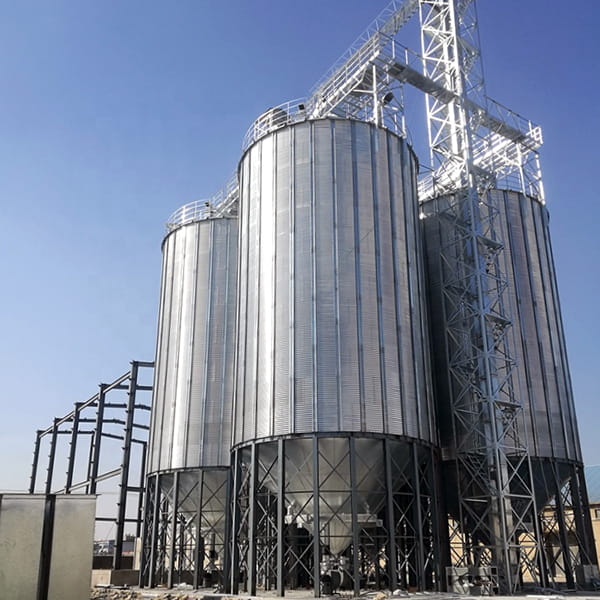
Similar to the flat bottom silos, the hopper tanks are assembled by fixing the corrugated silo panels to the stiffeners & wind rings with bolts & nuts.
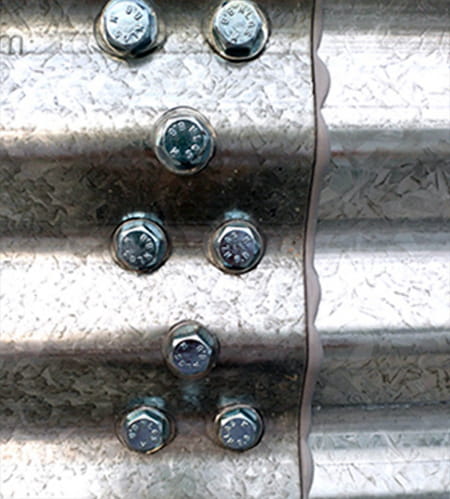
These corrugated grain bin panels are produced by an advanced silo roll forming machine, which consists of 10 tons unwinder, feeding leveler, roll former, hydraulic punching machine, online curving machine, and hydraulic cutter.
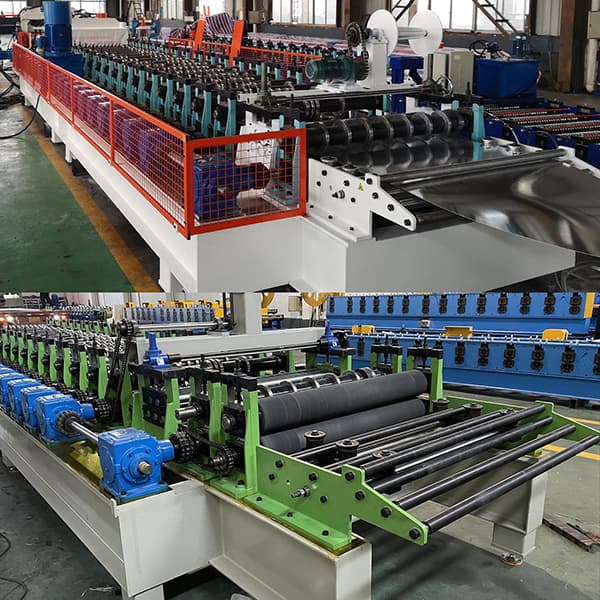
With such an advanced corrugated iron bending machine, the produced panels are of high quality to withstand your strict requirement.
In order to understand the product flow in the hopper tanks more clearly, we SiroSilo will have a detailed discussion with you on the characteristics of the stored material, and then design the hopper cone based on the discussion results.

To prevent the hopper tanks from corrosion, all metal parts are galvanized.
Structures
Cone grain bins have a conical top and bottom, and a cylindrical body between them.
- Roof
- Cylindrical Body
- Hopper Cone (Bottom)
- Structural Support (Bottom)
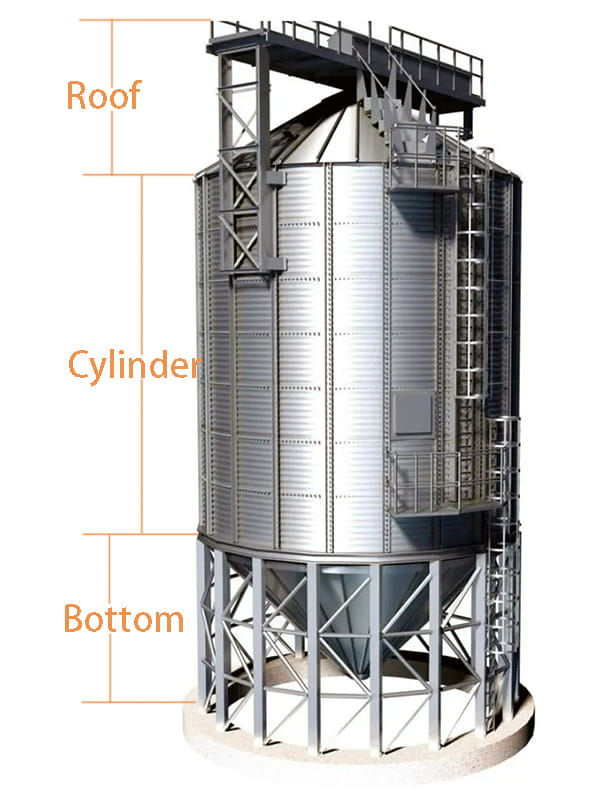
As the supplier of COFCO (the largest grain company in China), SiroSilo is a professional hopper silo manufacturer worthy of your trust.
If you want to know more about our hopper bottom silos, please send us an inquiry on this website, or you can contact us via WhatsApp, we could lively broadcast our factory to you via video call.
Email: info@sirosilo.com
WhatsApp: +8617312124727
Hopper Silo Ultimate FAQ Guide
Galvanized Steel Silo
Galvanized silo is actually a steel grain silo, it is assembled by hot-dip galvanized corrugated steel panels.
Galvanizing refers to the surface treatment technology of coating a layer of zinc on the surface of metals, alloys, or other materials, the main process is hot-dip galvanizing.
Hot-dip galvanized corrugated metal panels have ideal corrosion resistance, in the foreign market, steel silo manufacturers use galvanized layers of different thicknesses, the common ones are Z-275, Z-450, and Z-600, and the number after Z indicates the galvanized grams per square meter on the surface.
In the Chinese market, Z-275 is the most common, and the 275gsm hot-dip galvanized layer could also ensure the metal silo is in service for more than 30 years.
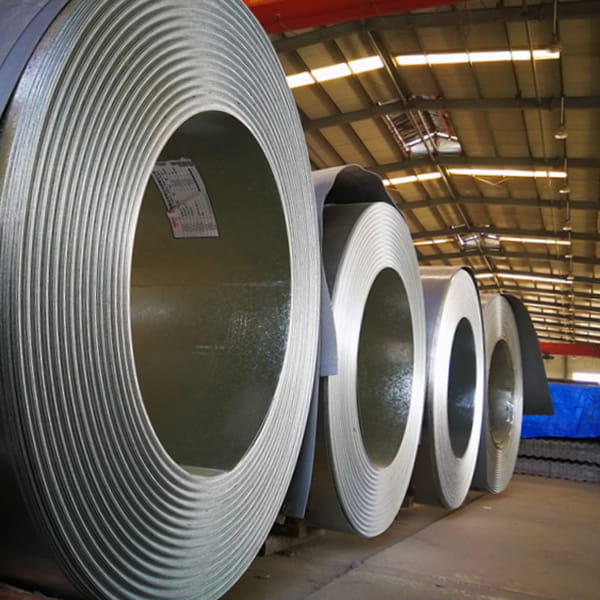
Galvanized Steel Coil
In addition to corrugated silo panels, the hot-dip galvanizing process also involves the surface treatment of auxiliary equipment such as bucket elevators, scraper conveyors, and belt conveyors, ensuring that all related facilities of the metal silo project have strong corrosion resistance.
Compared with paint coating, the cost of galvanizing is much lower.
Common paints include plastic and epoxy paint, both of which are not as rust-proof as galvanized coatings;
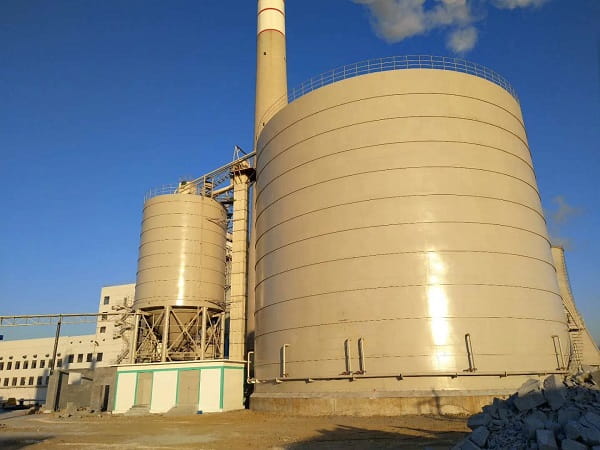
Paint Coating
Moreover, painting for the entire metal silo is costly (labor, raw materials, and time) and difficult, and the painting quality depends entirely on the proficiency of workers.
Hopper Bottom Silo
- What is Hopper in Silo?
- How Does a Hopper Bin Work?
- Hopper Silo Components
- Cone Bottom Silo Volume Calculator
- Fertilizer Hopper Bin
- Hopper Bottom Grain Bins
- Hopper Bottom Feed Bins
- Flat Bottom VS Hopper Bottom Silo
- Hopper Silo Manufacturers
- Hopper Bottom Grain Bins Prices
- How to Build a Hopper Bottom Grain Bin
What is Hopper in Silo?
According to the bottom shape, there are two types of metal grain silo: the flat bottom silo and the hopper bottom silo.
The hopper in a silo is actually the reverse cone at the bottom of grain hopper bins.
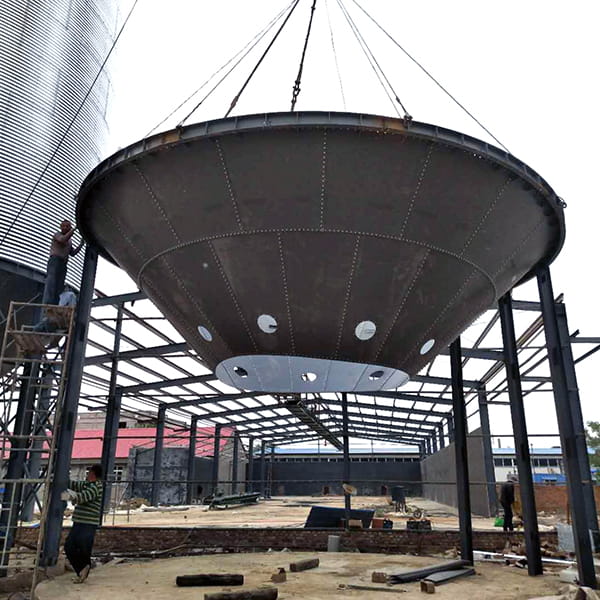
Because of the reverse cone, these grain hopper bins are easier to discharge the stored grains without clearing equipment. You only need to open the discharge outlet, and the grain will flow out automatically by gravity.
The conical bottom bin requires less auxiliary equipment, less power consumption for unloading, and fewer maintenance resources and manpower input.
In addition, the cone bottom silos allow for a higher support structure, ensuring trucks pass through and load grain.
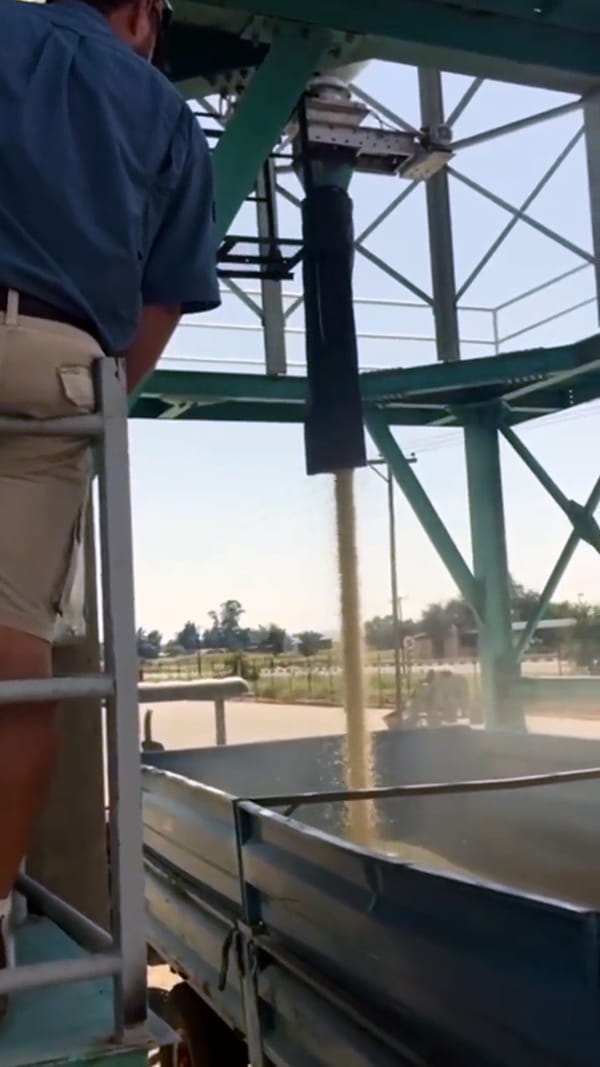
The cone bottom bins are especially suitable for customers with the following needs:
- Short-term grain storage;
- Easy grain unloading;
- Grain unloading onto trucks or trains.
How Does a Hopper Bin Work?
Regarding “How Does a Hopper Bin Work?”, it mainly involves three aspects: grain loading, grain monitoring, and grain unloading.
Grain Loading
A truck full of grain stops on the hydraulic dumper, and the hydraulic dumper slowly lifts up, dumping the grain into the pit.
Then a drag conveyor conveys the grain into the bucket elevator from the dump pit.
Next, the bucket elevator lifts the grain up to roof height, empty the grain to the scraper conveyor on the silo roof, then the grain enters the corresponding silo through the outfeed gate of the drag conveyor;
Or the grain in the bucket elevator flows directly into the hopper silo through a feeding chute.
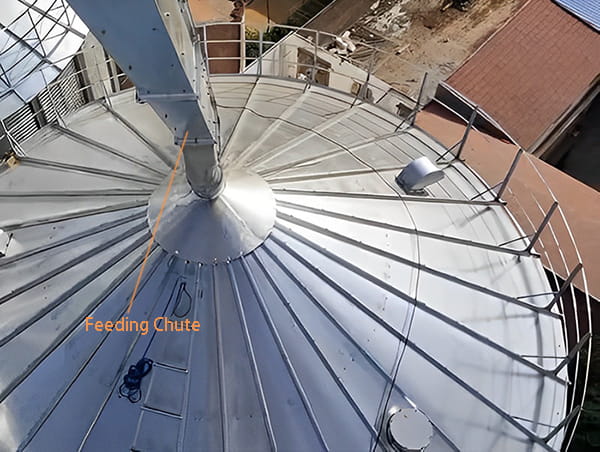
Grain Monitoring
After the cone bottom silo is full of grain, the grain temperature is monitorable in real time through the temperature-measuring cables.
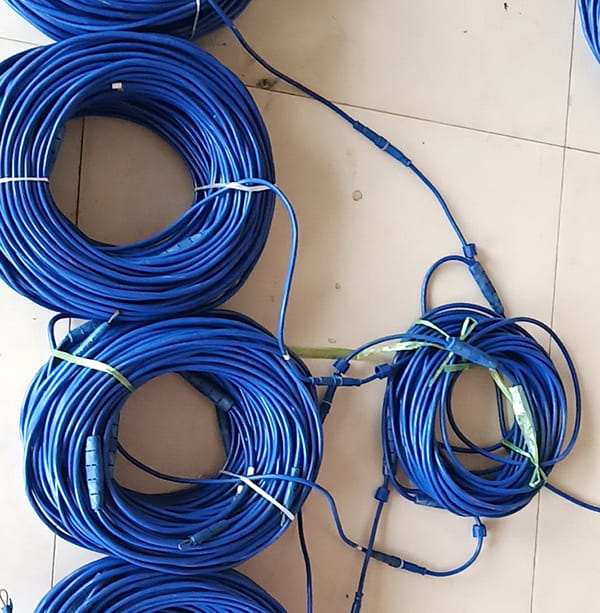
There is a measurement point every two meters, in multiple directions and at multiple levels.
Once there is a temperature rise, the ventilation system starts to cool down the grain, keeping material storage safe.
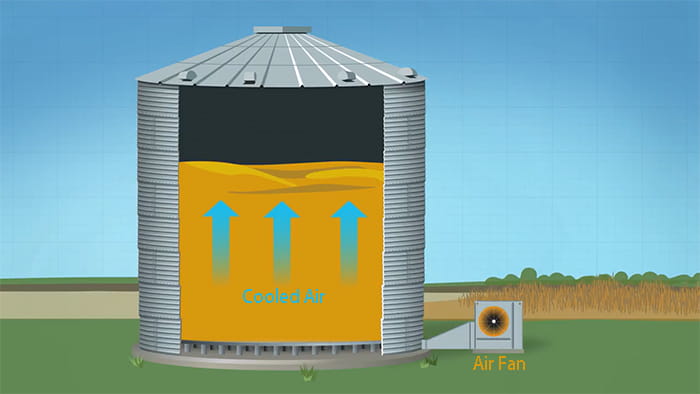
Grain Unloading
The grain flows naturally from the cone bottom bin under gravity during the unloading process.
When you unload grain, first place a belt conveyor or screw conveyor underneath, and the conveyor transports the grain to the truck or other grain storage facility.
After the conveyor is in place, open the discharge gate of the cone-bottom bin, and the material flows into the conveyor naturally.
Hopper Silo Components
Roof
Depending on the silo diameter and roof load, the roof is with or without a support structure.
- Small Diameter & Roof Load
The roof consists of roof collars, roof sheets, roof reinforcement ribs, an inspection door, vents, and roof stairs.
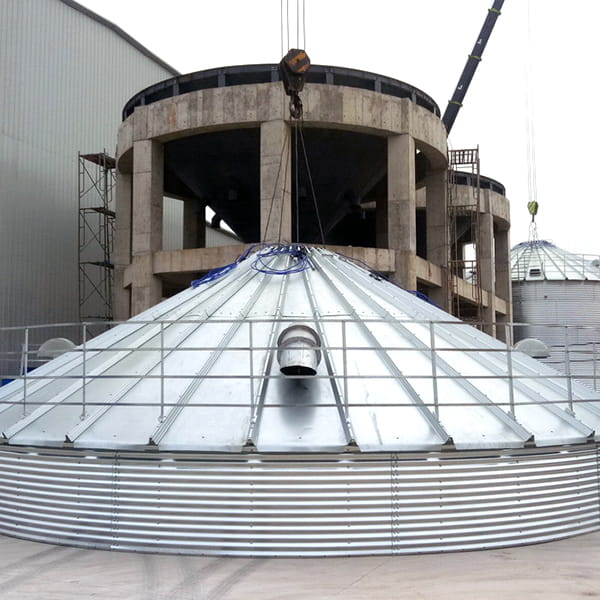
- Large Diameter & Roof Load
Structural roof, supporting structure involves rafters, purlins, support rings, etc., which can bear greater snow load.
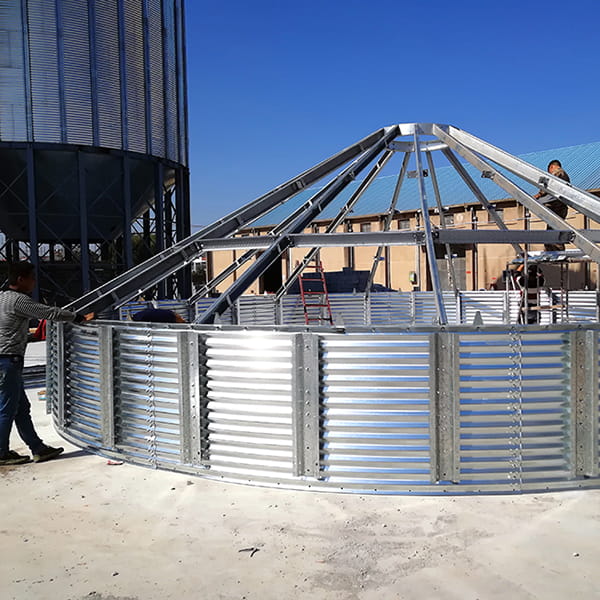
Of course, roof collars, roof sheets, manholes, vents, and roof ladders are also essential.
Cylinder Body
The cylinder body of the conical bottom silo includes sidewall sheets, stiffeners, wind rings, and an access door.
- Sidewall Sheets
Arc-shaped, corrugated, and galvanized, they are spliced piece by piece to form a cylindrical bin body.
Each sidewall sheet is 1.12 meters high, you could calculate the silo height according to the rings of the sidewall sheet because such grain bin building is done by continuously adding rings of corrugated silo panels from bottom to top.
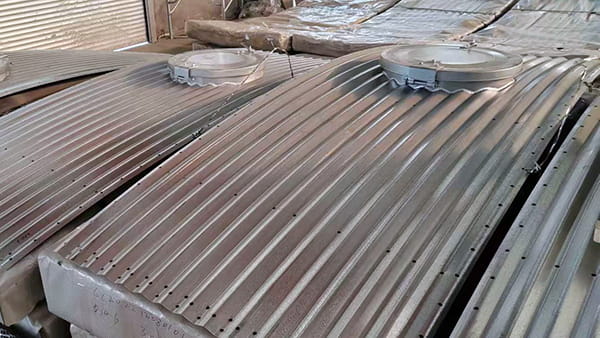
In order to strengthen the vertical bearing capacity, the side wall sheets are connected with stiffeners every certain distance.
- Stiffeners
Ω-shape, which fixes the sidewall sheets and shares the vertical load.
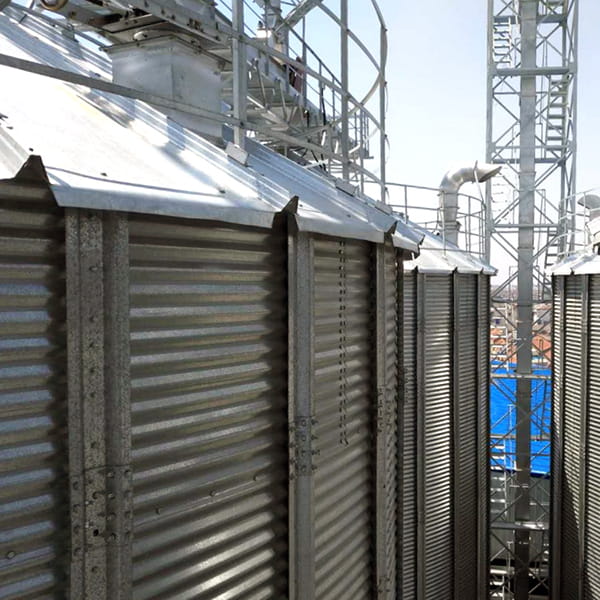
- Wind Rings
The ring-shaped round pipe connects to the stiffeners, avoiding silo deformation due to wind pressure when the silo is empty without any material inside.
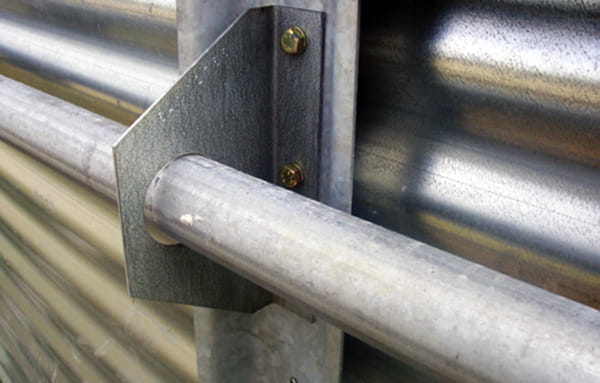
For areas with frequent strong winds, it’s better to install as many wind rings as possible.
- Access Door
Rectangular, consisting of two layers of galvanized steel sheets inside and outside, hinges screw the two layers together.
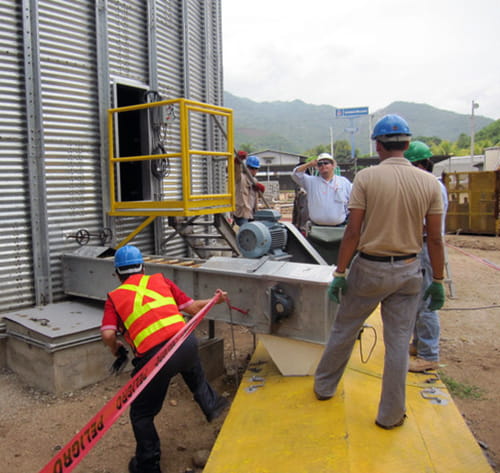
Bottom
The bottom consists of hopper sheets, a support structure, and a hopper cone.
- Hopper Cone
Trapezoidal galvanized steel sheets are assembled one by one to form a hopper shape.
Its top connects to the cylinder body, its bottom links to the hopper cone, and the level detector and ventilation ducts attach to its inner surface.
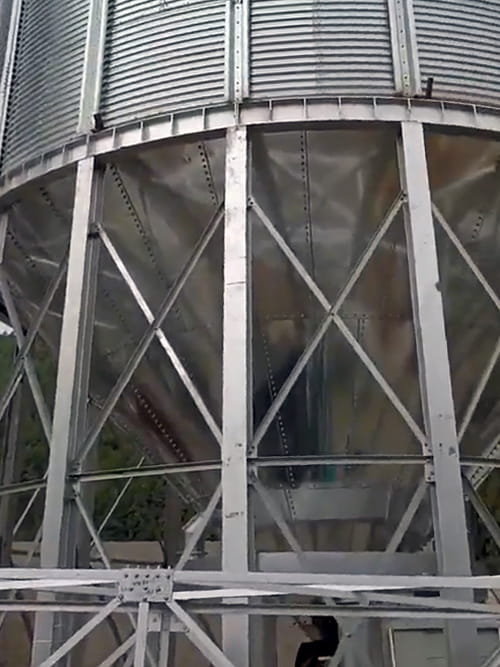
In order to facilitate the aeration system operation, manufacturers usually prefabricate a reserved hole for air fan ducts.
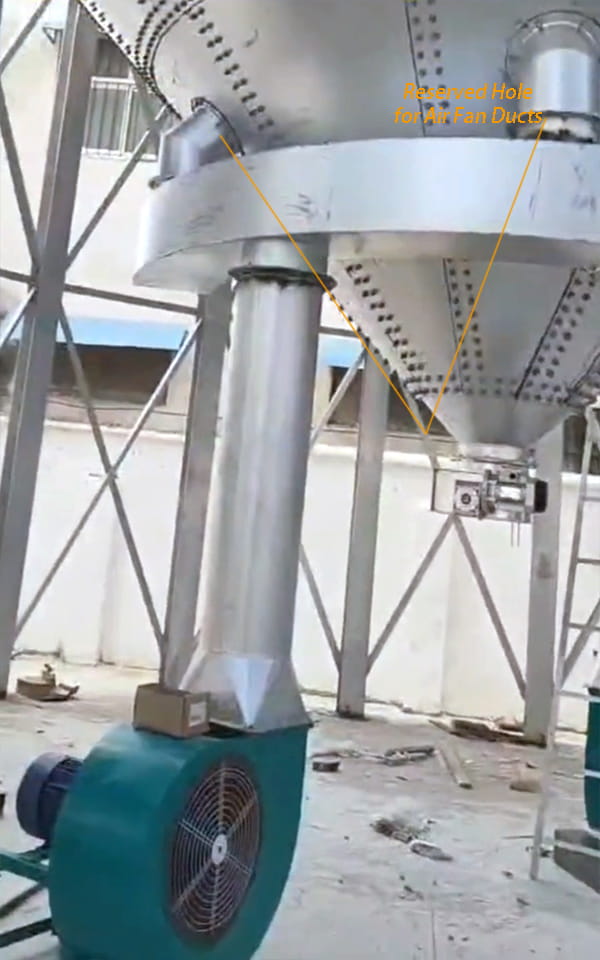
There is a slide gate at its very bottom for material unloading.
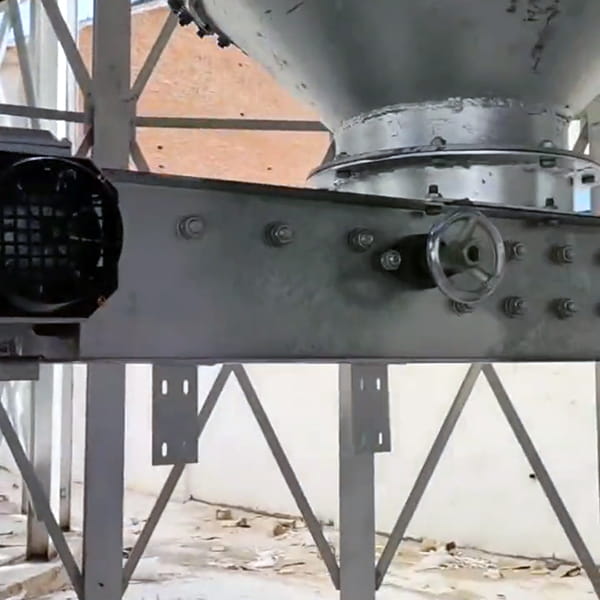
- Support Structure
Steel columns connected by bracings with anchor plates at the top and bottom.
Its top connects to the cylindrical body and its bottom links to the foundation.
Control System
There are three main control systems for cone bottom silos: level sensing, temperature monitoring, and aeration.
- Material Level Sensing
When the cone bottom bin is almost full of materials, the material level sensor will prompt to avoid overflow.
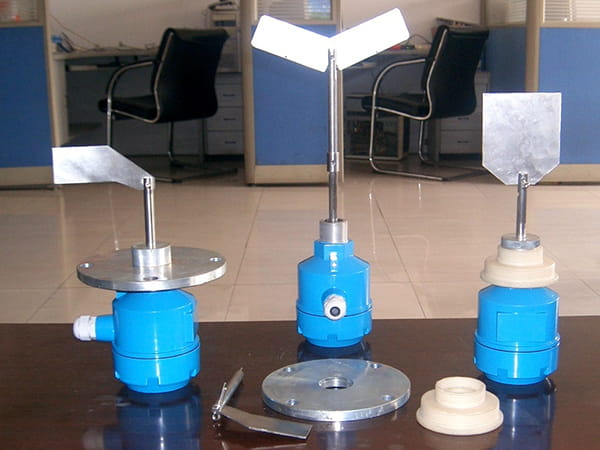
Rotary Paddle Level Sensor
- Temperature Monitoring
During the material storage process, you need to monitor the temperature of the material in the bin in real-time, to ensure the safety of the material.
The temperature monitoring system consists of many vertically suspended temperature measuring cables, and control hosts, etc.
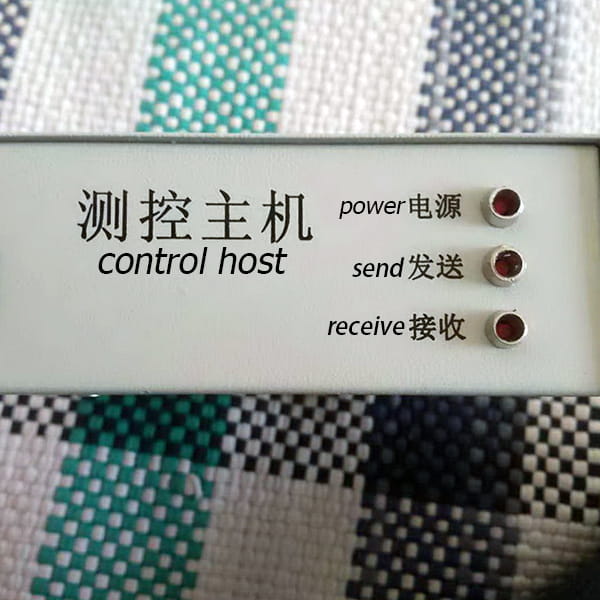
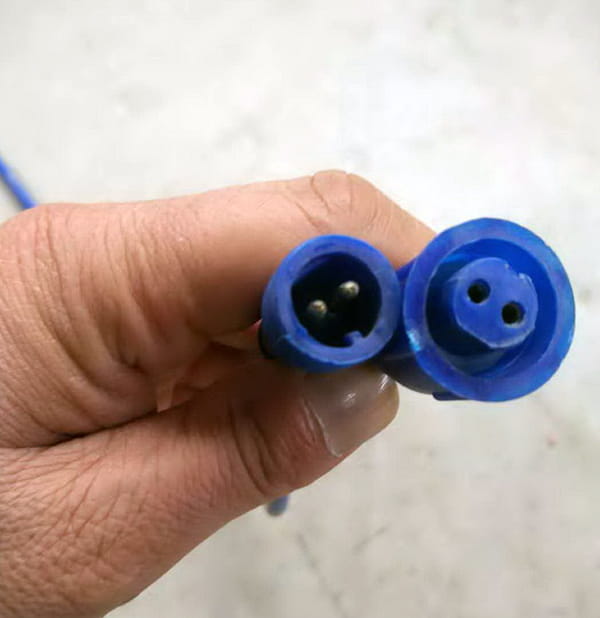
- Aeration
When the temperature monitoring system detects an increase in temperature, it can feed back commands to the aeration system and turn it on.
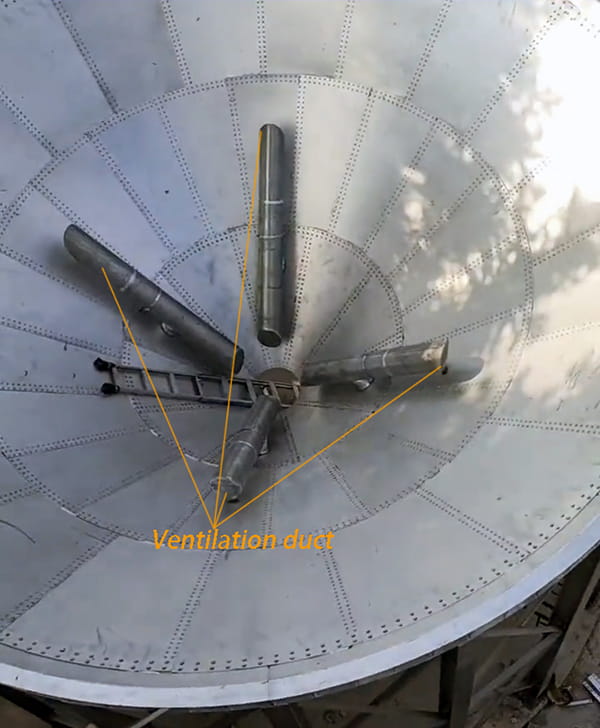
The linkage between the temperature monitoring system and the aeration system effectively reduces the material temperature in time, ensuring that the materials do not deteriorate.
Auxiliary Equipment
Drag Conveyor
The drag conveyor is a large-capacity conveying device, which is capable of transporting bulk materials horizontally and upwardly. Its main material is hot-dip galvanized steel, painted steel, or stainless steel according to customer requirements.
When it is running, the chain driven by the reducer drags a series of paddles (or blades), and these paddles drag the material along the material flow direction.
In the corrugated steel silo project, the dray conveyor transports the granular, flake, or powder materials from the dump pit to the elevator horizontally, and is also responsible for loading the materials from the bucket elevator to the steel silo.
- Manganese steel chain, high tensile strength, long service life;
- Profiled steel sheet & angle steel welded, high strength, and great sealing;
- Polymer wear-resistant material guide rails eliminate sliding noise and reduce power consumption;
- Flexible process layout, multi-point discharge, quick open inspection window;
- Adjustable speed, anti-blocking & anti-broken chain device, safe and reliable;
- Computer-aided design, accurate motor & reducer matching, high efficiency & energy saving;
- Simple assembly and maintenance.
Bucket Elevator
The bucket elevator is conveying equipment that conveys grain vertically upward without damaging the material.
Its material is hot-dip galvanized steel, carbon steel, or stainless steel according to special needs.
In the metal silo project, it is responsible for receiving the material from the scraper conveyor, lifting the material to the roof height, and then pouring it into the scraper conveyor or feeding chute.
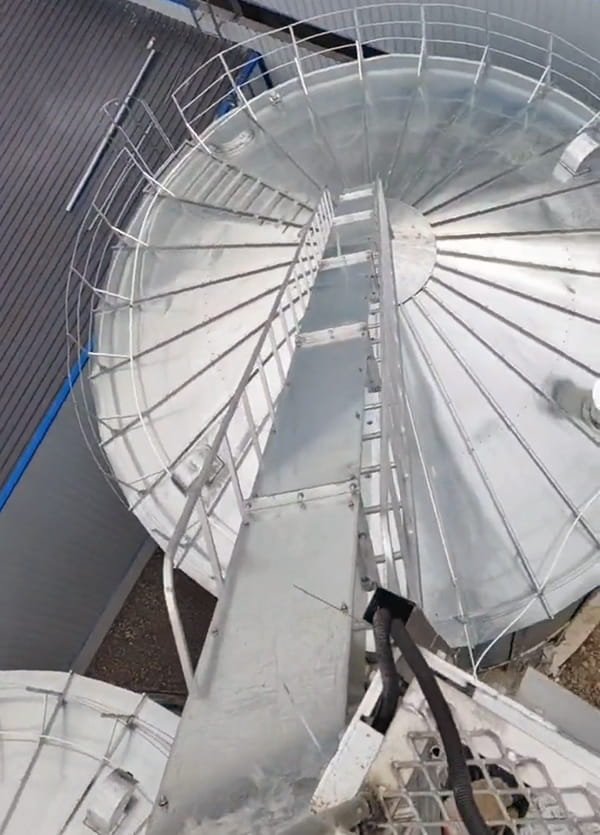
- Refined rubber-covered head, wear-resistant, prevents the belt from slipping, safe operation with a full load;
- Lightweight & high-strength plastic bucket, low breakage rate, long service life, and bucket material is customizable;
- High-strength nylon belt with low elongation;
- Welded casing by cold-rolled steel sheet, with good strength and sealing performance;
- Well-known motors and reducers, simple installation & maintenance;
- Optional speed & belt deviation detection system;
- Emergency buttons at several points.
Drum Pre-cleaner
The pre-cleaning system is an important piece of equipment for the steel silo project, which effectively improves the quality & stability of grain storage.
In order to ensure the impurity removal effect, SiroSilo recommends that you choose a double-drum pre-cleaner.
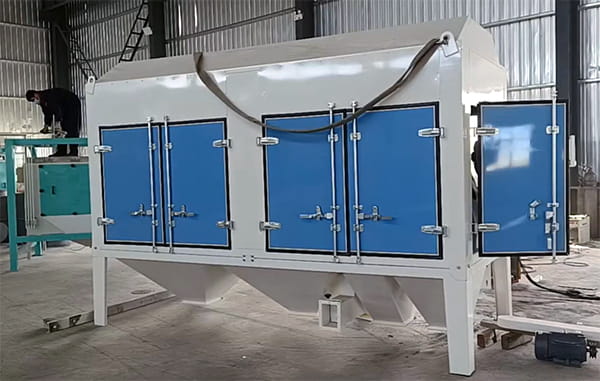
The double-drum pre-cleaner separates various impurities such as dust, branches, weeds, etc. from different types of grains (barley, wheat, rice, soybeans, corn, rapeseed, etc.).
It has a good impurity removal effect, and its processing capacity ranges from 20 tons/h to 180 tons/h.
- Beautiful appearance, compact structure, long service life;
- High-strength structural design, high cleaning efficiency, and low energy consumption;
- Adjustable sieve hole diameter according to the material;
- Sieve is controllable by sampling control points;
- Adjustable drum inclination angle by automation, separating large, medium, and small impurities simultaneously;
- Adjustable drum rotation speed;
- Simple installation, convenient maintenance, and easy replacement of the drum.
Dust Collecting Systems
During the grain loading and unloading processes of the galvanized steel silo, they generate a large amount of dust, and many grain processing plants will introduce dust collecting systems to meet the requirements of environmental protection.
The dust collecting system consists of a centrifugal fan, pipeline, cyclone separator, pulse dust collector, rotary airlock valve, etc.
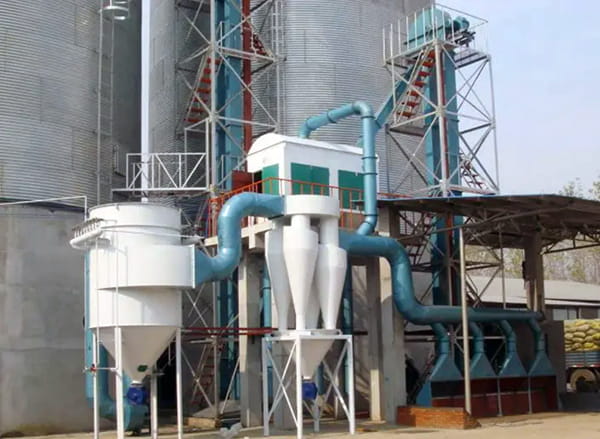
A centrifugal fan draws the dusty air into the pipeline, and the dusty air first passes through the cyclone separator to remove large particles of dust.
Then the dusty air exits the top of the cyclone separator and enters the pulse dust collector.
The pulse dust collector separates air & particulate dust, then discharges clean air through its top outlet.
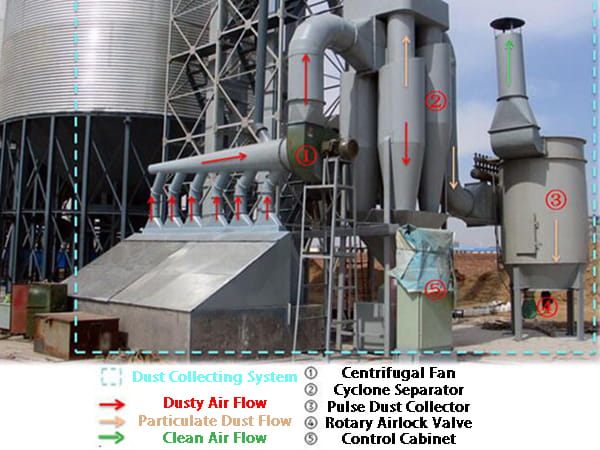
Magnetic Drum Separator
From harvesting to processing, grain has to go through many steps, during which various metal substances such as iron nails, screw washers, etc. will be mixed.
If these metal substances enter the high-speed machine with the grain, they will seriously damage the machine parts; or even generate sparks due to collision & friction, causing a dust explosion accident.
At the same time, during processing, due to the wear or oxidation of machine parts, some metal debris or powder will also appear.
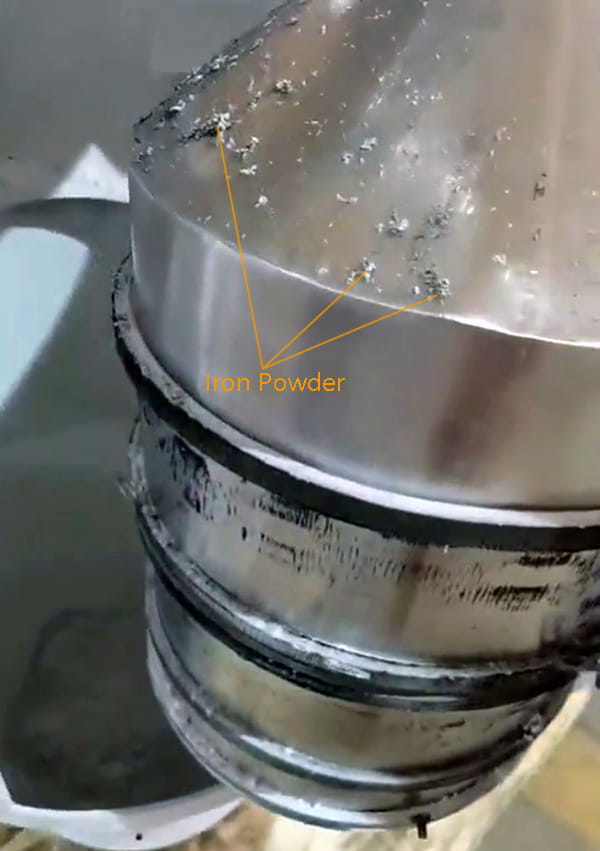
When these impurities are mixed into the grain, it will endanger human health; if mixed with feed, it will also hinder the raising of livestock.
It is necessary to take suitable measures to remove these metal impurities, and magnetic separation is the answer.
Many food factories have introduced magnetic drum separators to clean up magnetic metal impurities.
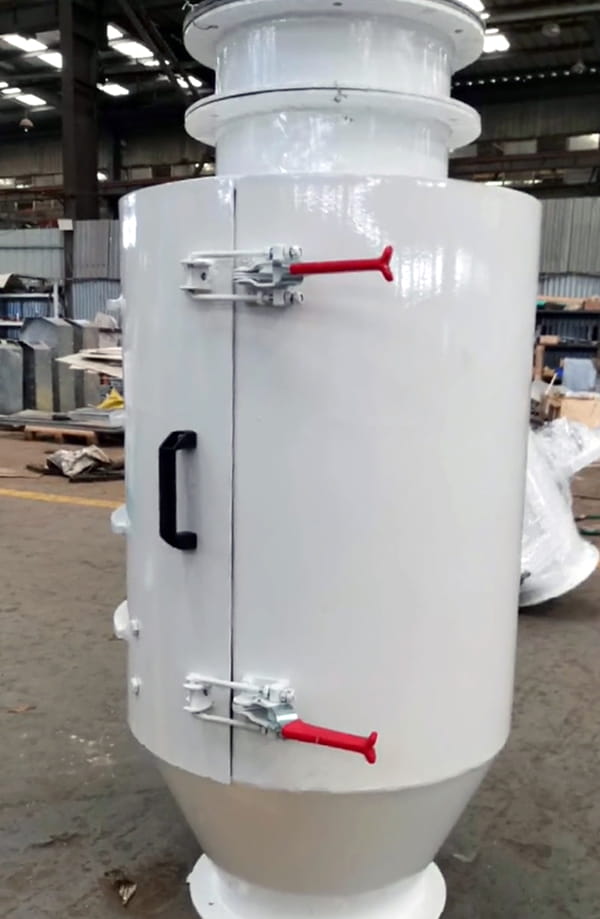
Grain is a non-magnetic material and can pass through the magnetic drum separator freely;
And any magnetic substances (Fe, Co, Ni elements and their alloys, some Mn compounds, rare earth elements, and their alloys, etc.) are adsorbed by the magnetic drum and separated from the grain.
Belt Conveyor
A belt conveyor is one of the common material conveying equipment. It consists of a frame, conveyor belt, idler roller, motorized pulley, tensioning device, transmission device, and so on.
There are two pulleys at both ends of the machine, a row of idler rollers locate between the two pulleys, and the belt wraps around the pulleys at both ends and rides on the idler rollers.
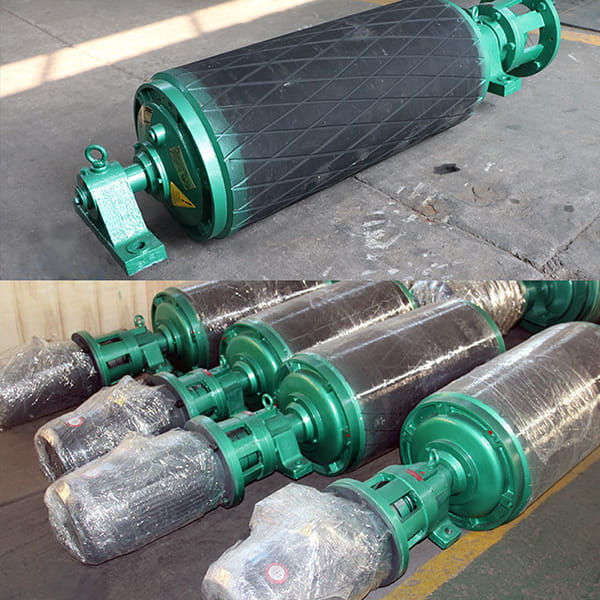
The motor drives the reducer first, then the reducer drives the drum pulley at the discharge end to rotate, and the friction between the drum pulley and the belt moves the belt to realize continuous conveying of materials.
It is suitable for conveying materials with a bulk density of less than 1.67 tons per cubic meter, suitable for conveying both bulk, granular, and blocky materials.
For flour mills, feed processing plants, oil plants, starch plants, mining farms, and chemical plants with metal silos, they often introduce belt conveyors to transport soybeans, corn, sorghum, rice, wheat, flour, minerals, cement, etc.
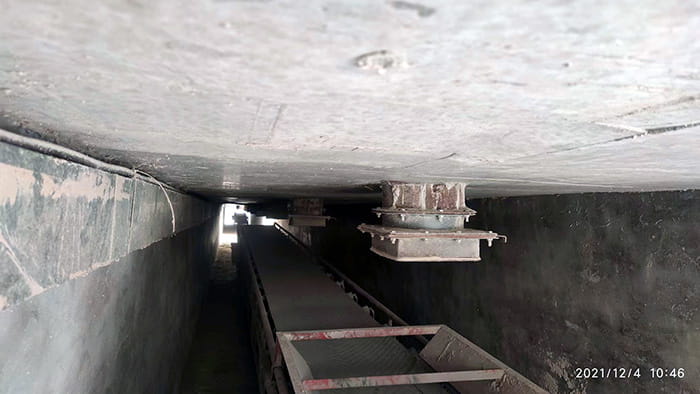
The belt conveyor can work alone, and can also co-work with other conveying equipment to form a horizontal or inclined conveying system to meet the needs of different customers.
- Long conveying distance;
- Large volume conveying;
- Fast speed, adjustable height;
- Strong versatility;
- Automatic and centralized control;
- Low material breakage rate;
- Easy to install, operate, maintain, and disassemble;
- Deviation correction, emergency stop, speed regulation, safety detection device;
- Rubber-covered drum pulley to increase friction;
- Quickly releasable belt tension;
- Customizable steel cover to ensure air tightness.
Cone Bottom Silo Volume Calculator
The cone bottom silo volume is equal to the volume of the top and bottom cones plus the volume of the middle cylinder.
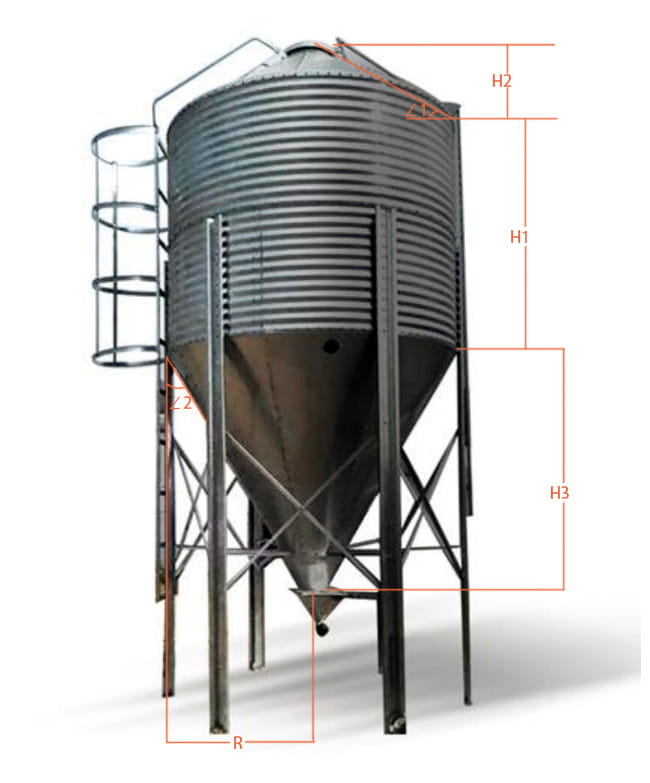
- V=cone bottom silo volume
- V1=middle cylinder volume
- π=3.14
- R=radius of hopper silo
- H1=height of middle cylinder
- V2=volume of conical roof
- H2=height of conical roof
- ∠1=inclination angle of conical roof
- V3=volume of conical bottom
- H3=height of conical bottom
- ∠2=inclination angle of conical bottom
V=V1+V2+V3=π*R2*H1+1/3*π*R2*H2+1/3*π*R2*H3=π*R2*H1+1/3*π*R3*tan∠1+1/3*π*R3*tan∠3
Please click the photo below to calculate your cone bottom silo volume online if you already know its diameter, roof height, cylinder height, and cone height.
Fertilizer Hopper Bin
Fertilizer hopper bins must meet relevant standards, and grain silos are unsuitable for storing fertilizers.
Only certain recommended types of fertilizers are storable in fertilizer hopper bins and the storage time should be as short as possible.
- Cone Degree
Fertilizer is denser than grain, only stronger silos are capable of holding the fertilizer.
In addition, the fertilizer fluidity is not as good as that of the grain, and the cone degree should be larger, at least 45°.
- Load
Sometimes, the actual density of the fertilizer may exceed the theoretical value, so you’d better discuss the cone bottom bin design with the manufacturer to ensure that it is capable of storing the densest fertilizer.
- Filling & Discharging
When filling and discharging fertilizers, try to use belt conveyors to transport fertilizers instead of screw conveyors.
During the operation of the screw conveyor, it will generate dust.
After the dust attaches to the fertilizer granules, the surface area of the fertilizer granules increases greatly, then the fertilizer granules are easier to absorb moisture in the atmosphere, which will cause the fertilizer granules to solidify during storage.
In addition, the auger continuously rubs against the fertilizer granules during the rotation process, damages the coating agent and oil on some fertilizer granules, and the waterproof function is lost.
Hopper Bottom Grain Bins
Generally speaking, many customers use the hopper bottom grain bins as a transit, storing grain & seeds for a short period of time.
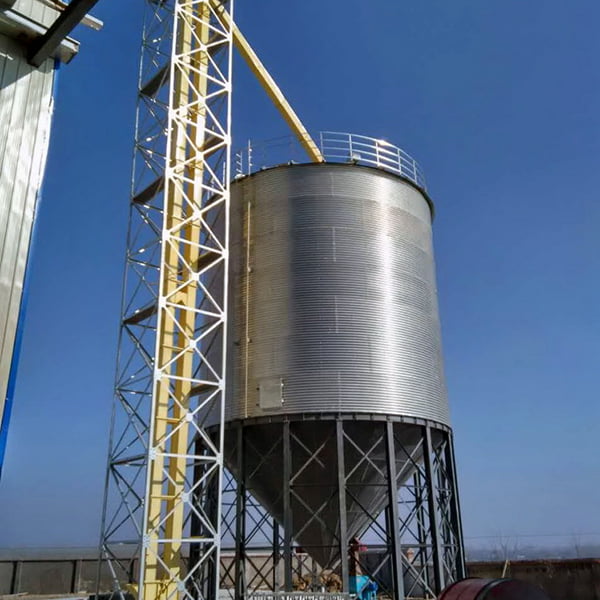
When the storage period is up, the unloading is also very convenient.
Because its bottom is a hopper cone, and the hopper cone has a certain height above the ground, thus the grain & seeds in the hopper bottom grain bins can flow out automatically under gravity.
Hopper Bottom Feed Bins
Because the farms use fodder to feed poultry & livestock every day, hopper bottom feed bins are more popular among farmers.
The hopper bottom feed bins are particularly convenient for unloading, it does not require unloading equipment.
It is economical.
Flat Bottom VS Hopper Bottom Silo
The difference between corrugated steel flat bottom silo and hopper bottom silo mainly involves capacity, foundation, material unloading, etc.
- Capacity
The maximum capacity of the corrugated steel hopper bottom silo is 1800 tons, and the maximum diameter is 11 meters.
If the diameter and capacity of the hopper bottom silo continue to increase, the height of the conical bottom increases.
Then the cost of the entire support structure is greater than the cement foundation of the same capacity flat bottom silo.
Therefore, if you plan to purchase a steel silo with a capacity of more than 1,800 tons, we suggest you choose a flat bottom silo.
- Foundation
The foundation of the flat bottom silo is cement pads, while the support structure of the hopper silo is steel legs and brackets.
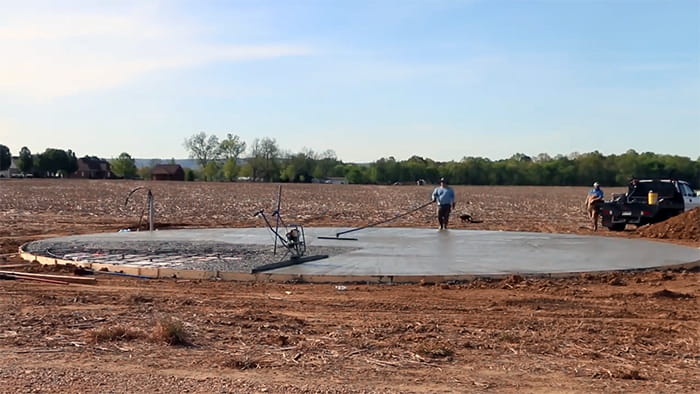
- Material Unloading
There is no doubt that the material unloading of the cone bottom bin is more convenient than the flat bottom bin because the hopper tank does not need unloading equipment, as long as you open the outfeed gate, the material will flow out naturally under gravity.
When unloading flat-bottomed bins, a sweep auger is essential.
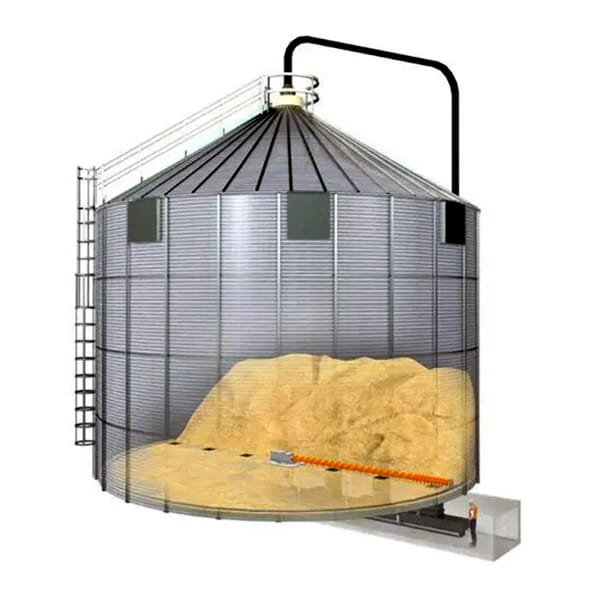
The sweep auger cannot completely empty the material, thus workers need to enter the bin to completely empty it.
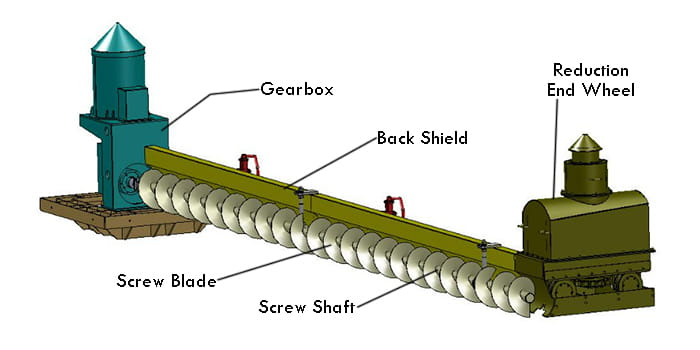
Hopper Silo Manufacturers
There are hopper silo manufacturers all over the world.
Relatively speaking, the hopper silo companies in the photo below are the top players in this niche.
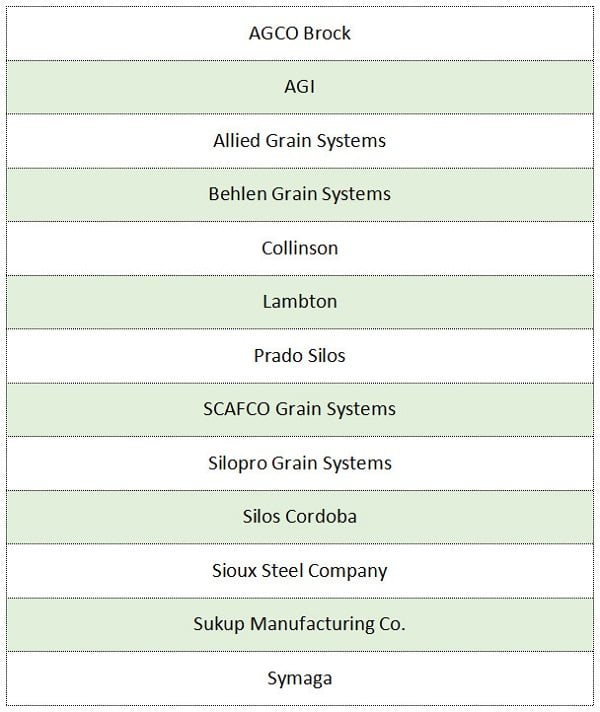
As the supplier of COFCO, SiroSilo is also a professional hopper bottom silo manufacturer worthy of your trust.
Welcome you to get a quote from us for comparison, or you can add our WhatsApp for a video call, and we can lively broadcast our factory to you.
Email: info@sirosilo.com
WhatsApp: +8617312124727
Hopper Bottom Grain Bins Prices
In the Chinese market, 3-30 tons of hopper bottom grain bin is RMB3,809.52 to RMB7,936.50/set, which is equal to USD$605.00-USD$1,260.00/set.

How to Build a Hopper Bottom Grain Bin
Building a hopper bottom grain bin includes the following steps:
Foundation Construction
Hopper bottom grain bin foundation construction steps:
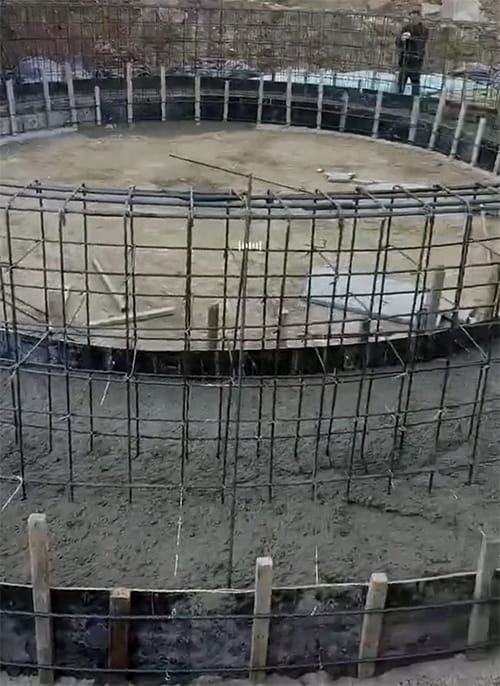
- Dig two to three meters deep under the ground, if it is a large bin, you should dip deeper;
- Make a cement pad with a thickness of 20 to 30 cm, and the deviation of the flatness shall not exceed 4 mm;
- On the hardened cement pad, bind the foundation steel bars according to construction drawings, and bind some embedded parts together;
- Enclose all the steel bar mesh with hoarding boards, and continue pouring foundation concrete;
- Masonry brick foundation;
- Backfill the foundation.
So far, the foundation construction is over.
Roof & Cylinder Body Assembly
After inspecting the concrete foundation, place the lifting equipment first, optional lifting equipment includes chain block, boom truck, crane, large forklift, and hydraulic jacks.
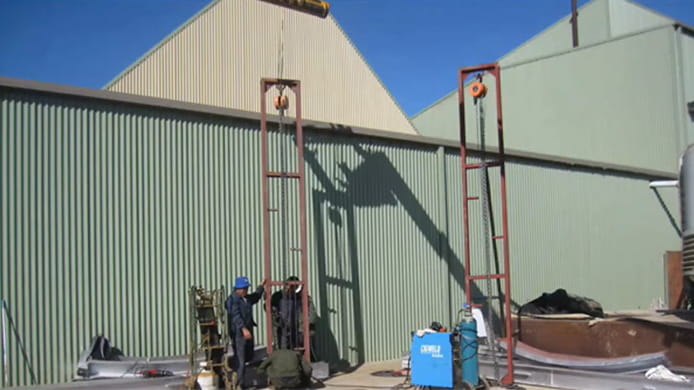
Install the sidewall sheets of the 1st ring.
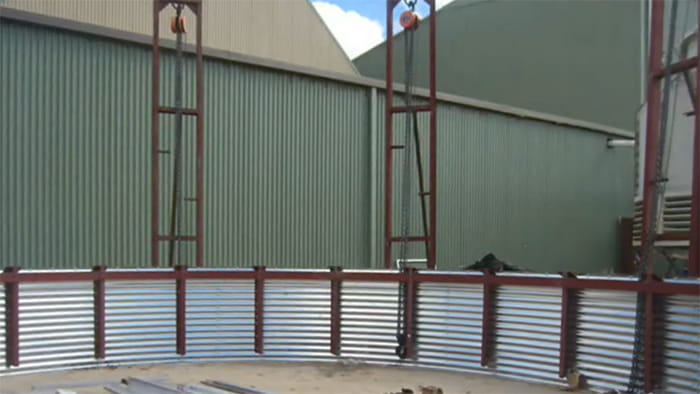
Assemble the roof, and first lift the peak ring.
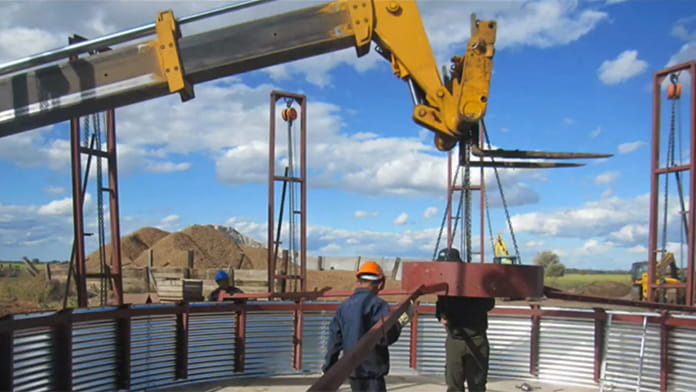
Then connect the peak ring to the sidewall sheets of the 1st ring with multiple reinforcement ribs.
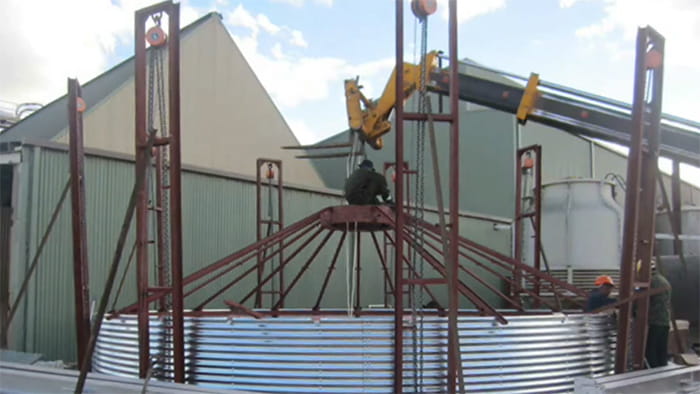
Next, put the roof sheets on the reinforcement rib.
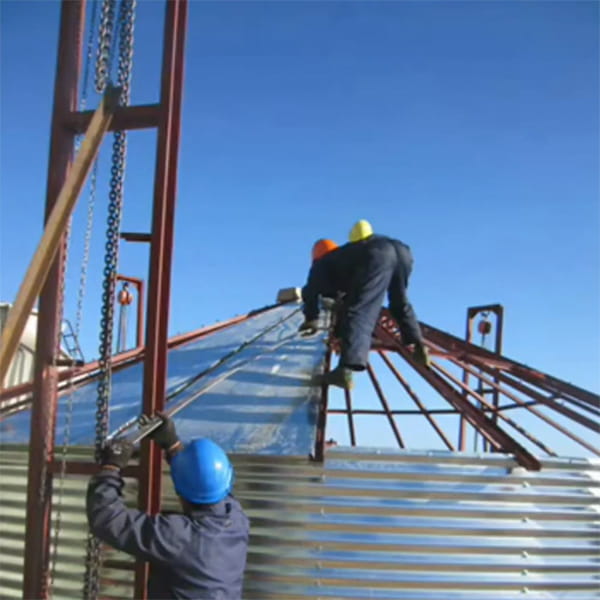
Install the sidewall sheets of the lower rings, each time after installing a ring, lift it with a chain block until the entire cylindrical body assembly is completed from top to bottom.
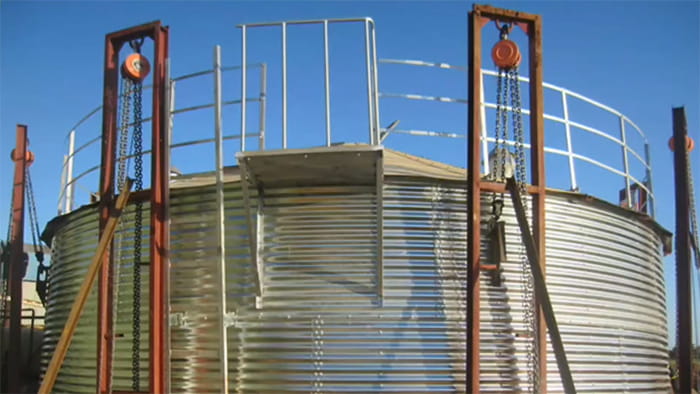
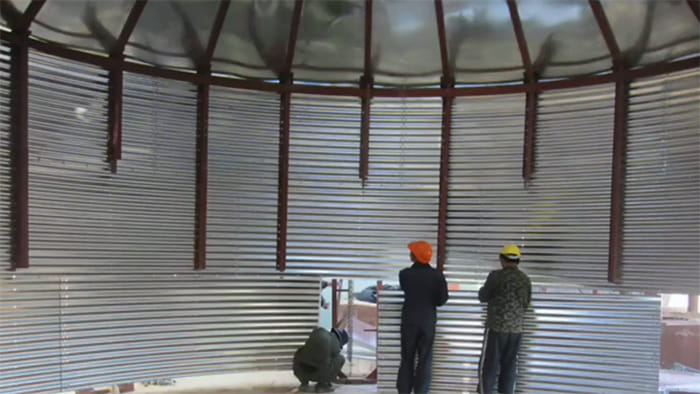
Support Structure Erection & Hopper Cone Assembly
Lift the assembled roof and cylindrical body to one side for later use.
To install the hopper bottom, lift the legs of the support structure first, then connect the bracing between every two different legs.
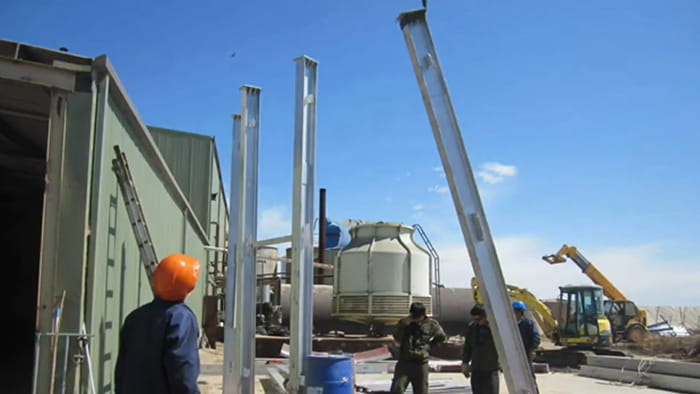
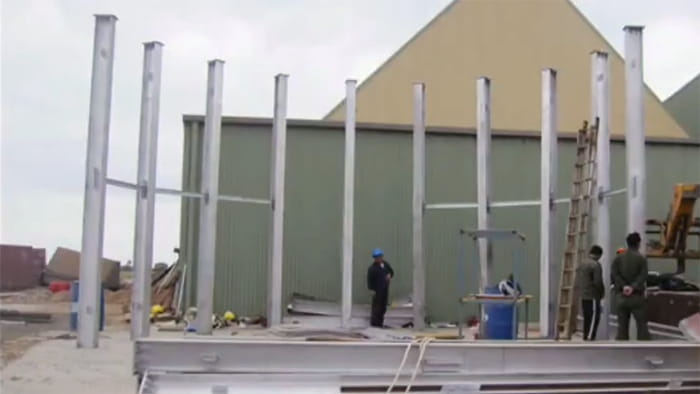
Install compression ring.
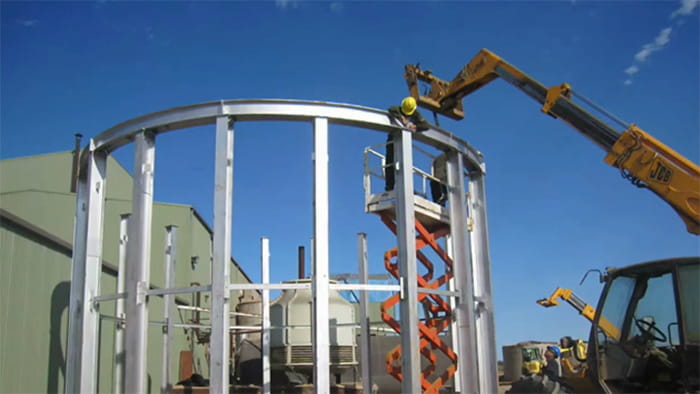
Install the hopper cone sheets from top to bottom.
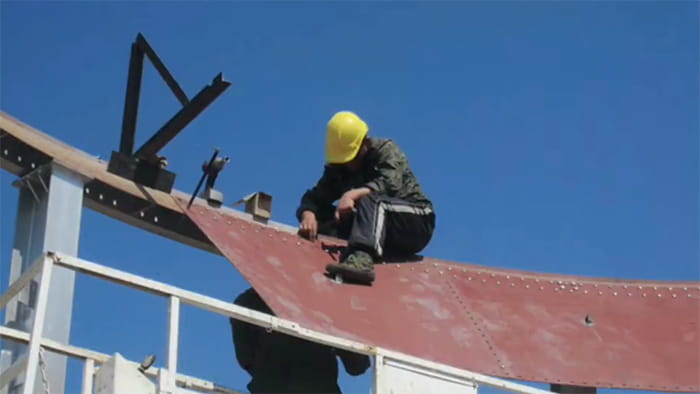
Roof & Body & Cone Integration
Lift the assembled roof and cylindrical body to the supporting structure, and fix the cylindrical body to the compression ring with bolts & nuts.
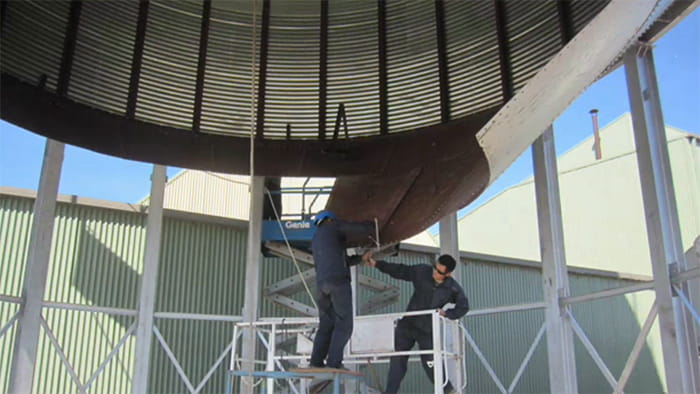
Welcome you to send us an inquiry on this site, we can send detailed specs & quotation sheets to you for comparison.
Email: info@sirosilo.com
WhatsApp: +8617312124727
 SiroSilo
SiroSilo
